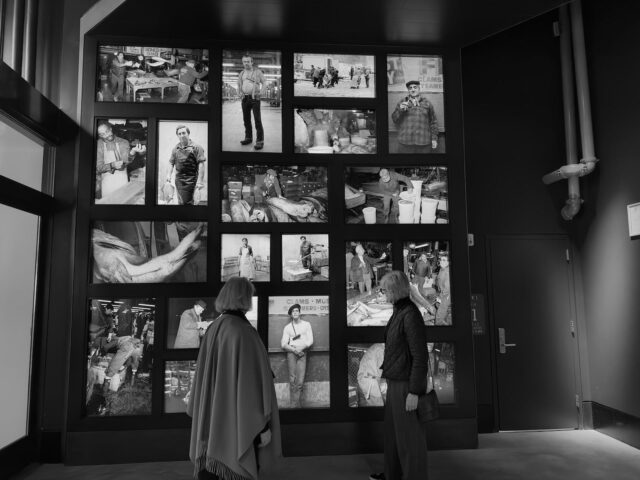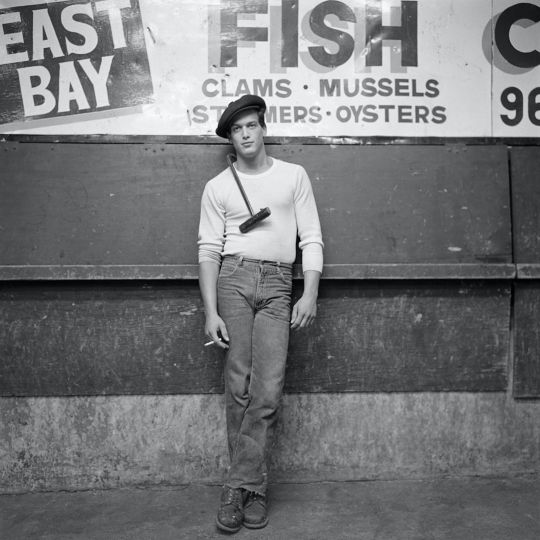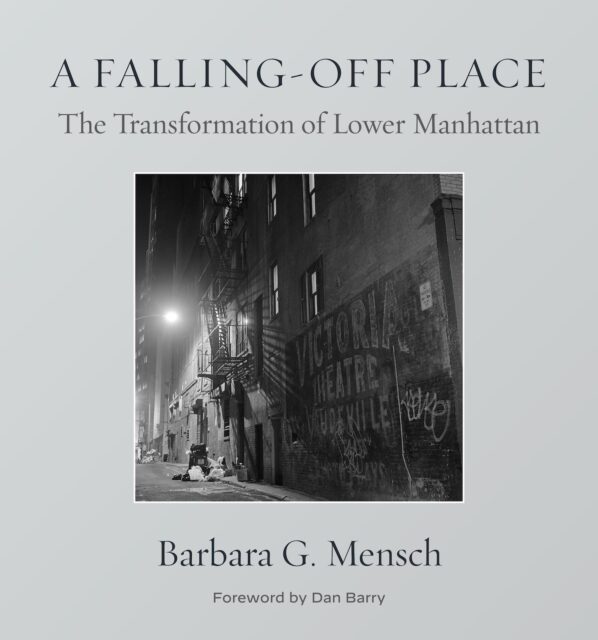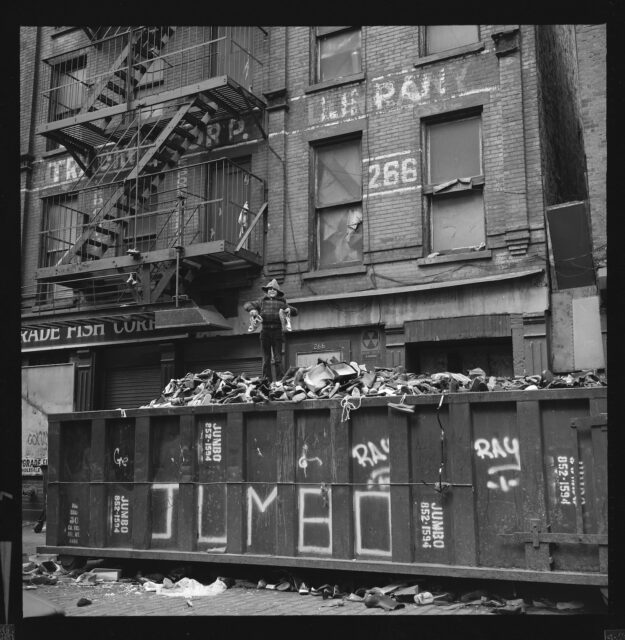
Barbara Mensch’s “The Nobility of Work” is a site-specific installation in the Tin Building (photo © Barbara Mensch)
A FALLING-OFF PLACE: THE TRANSFORMATION OF LOWER MANHATTAN
The powerHouse Arena, POWERHOUSE @ the Archway
28 Adams St. at Water St. @ the Archway
Wednesday, September 6, $7.18 includes $5 gift certificate, $47.73 includes copy of book, 7:00
Untapped Cities tour: Saturday, October 7, free with insider membership, 1:00
powerhousearena.com
menschphoto.com
“There is no longer any scent of what was. Thankfully, though, there is Barbara G. Mensch, whose images are like the conjuring rain,” journalist and author Dan Barry writes in the foreword to Barbara Mensch’s latest photography book, A Falling-Off Place (Fordham University Press, September 5, $39.95). “She is the Brooklyn Bridge of the New York imagination, linking the now and the then. She sees the incremental turns in the city’s inexorable evolution, the obliteration of the past by gentrification, the irreversible dominion of profit over preservation.”
The Brooklyn-born Mensch initially took up drawing and worked as an illustrator at Ms. magazine after graduating from Hunter College. She soon found that photography was her calling, documenting a changing New York City. She has spent nearly fifty years using a Polaroid SX70, a Rolleiflex, and now an iPhone, focusing primarily on Lower Manhattan. During the pandemic, she looked through her archive of unlabeled boxes of photos and gathered together black-and-white shots of the Fulton Fish Market, Chinatown, Peck Slip, and the Bowery, of demolition and decay, of a different era. She added shots of 9/11 and Hurricane Sandy to construct a powerful narrative.
“They became my personal visual timeline,” she writes in the introduction to the book, a follow-up to 2007’s South Street and 2018’s In the Shadow of Genius: The Brooklyn Bridge and Its Creators. “What did the passages of decades reveal to me? What dynamics were at play in my images of the same streets that I walked repeatedly for years? What fell off as the old was swept away by the new?”

“Vinny, an unloader, Fulton Fish Market, 1982” (photo © Barbara Mensch)
A Falling-Off Place is divided into three chronological sections: “the 1980s: making a living on the waterfront,” “the 1990s: setting the stage for a real estate boom / fires, floods, and neglect,” and “the new millennium: managing change / anxiety, optimism, and the uncertainty of historic preservation.” There are photos of the old Paris Bar, a dilapidated section of the FDR Drive, the Beekman Dock icehouse, and Pier 17 being torn down, along with portraits of such characters as Mikey the Watchman, Mombo, Vinny, and Bobby G., supplemented with quotes from Jane Jacobs, fishmongers, a retired boxer, and Robert Moses.
Many of the photos can also be seen in Mensch’s site-specific permanent installation, “The Nobility of Work,” in the restored and rehabilitated Tin Building on South St., which was originally built in 1907 on the space where the Fulton Fish Market began in 1835. The market moved to Hunts Point in the Bronx in 2005; the new Tin Building, which is celebrating its one-year anniversary in September, was commissioned by the Howard Hughes Corporation and features a 53,000-square-foot high-end food court and marketplace run by chef Jean-Georges Vongerichten.
On September 6, Mensch will be at the powerHouse Arena, in conversation with culinary documentarian Daniel Milder (Chef’s Table, Street Food Asia); she will also be leading an Untapped Cities tour on October 7. Below she discusses living downtown, being a woman in what was a man’s world, upcoming projects, and more.
twi-ny: When you first began photographing at the Fulton Fish Market, the men there were suspicious that you might be a government plant. What was that like?
barbara mensch: Well, what can I say? When I first began taking photos in the early 1980s, it was horrible. I would be taking photos and lo and behold, sharp (and I mean very sharp) pieces of ice would repeatedly be hurled at me. The fishmongers would use ice to preserve the seafood as it was stored in crates, and later in the early hours of the morning in coolers. I remember that the sharp pieces of ice could really hurt if thrown with tremendous velocity. Also, in the beginning there were many threats to my life, which were at the time palpable. Although the origins of this project were challenging, where I photographed the Fulton Market and the East River waterfront below the Brooklyn Bridge, I was intrigued and kept going forward.
As a side note, I was always very competitive with men and wanted to prove my worth. As a result, in the male-dominated world of the waterfront, the challenge was provoking. In order to create this project, a sense of gradual time had to be taken into consideration. Convincing men, who were hardened and determined to make a living within a certain number of hours in the harshest of conditions and had no room for me or my pictures. Working in this environment was a daunting task that was only achieved with a gradual, mutual feeling of trust. That came with years of interaction.
twi-ny: You have a permanent, site-specific exhibition at the Tin Building; how did that come about?
bm: After the Howard Hughes Corporation, which operates the new Tin Building, considered several different major artists for the space, they determined that I had the best understanding of the area and the strongest commitment in my pictures to the historical record.

twi-ny: The photos there and in your new book are both quintessentially New York and at the same time universal. Which photographers inspired you? Do you seek that dichotomy when you peer through the lens?
bm: My influences as an artist are vast and consequential. Although I am a photographer and have worked hard to perfect the art of printing and creating images, there are truly so many “heroes” that I have come to know over the years and try to follow their practices. One of my mentors was my friend Bruce Davidson, a legendary photographer who influenced me with his extraordinary wisdom into the creative process.
And I have also been influenced by countless other artists, primarily filmmakers, including Ingmar Bergman, Luchino Visconti, Roberto Rossellini, and more. Each artist, in his or her masterful way, chose to depict humanity in a raw and gritty reality. Rudy Burkhardt also comes to mind as a painter, photographer, and filmmaker whose images evoke a sense of New York as it passed into a new era. Many of these artists continue to resonate with me.
twi-ny: It’s hard to believe some of those pictures go back only forty years; things now seem so different from then. I can’t get the 1999 photograph of a security guard on Schermerhorn Row out of my head; it looks like it’s from a 1940s British noir. What kind of image instantly catches your eye?
bm: To answer your question, I always shoot “reflexively.” When I saw the security guard walking back and forth, blanketed in smoke and fog, I believe my unconscious was at work. Cinematic art has deeply influenced my work, so Frank Capra’s film Lost Horizon and Michael Powell’s captivating films where mystery is created in light and shadow impacted me greatly and often influence my work.
twi-ny: At the end of the book, instead of you being interviewed, you interview someone who tracked you down because of your photographs. What made you want to reverse the tables?
bm: Well, just to be clear, she found me. I thought that interviewing an individual who had some inside perspective on mob activities during the Giuliani investigations against organized crime during the 1980s would be provocative.
twi-ny: It certainly is that. In that interview, the two of you discuss gentrification and land grabs as well as Rudy. At one point, your subject says, “Men’s egos and thirst for power drove us off a cliff. That is the real ‘falling-off place.’” Do you see us ever climbing back from that? You spend much more time photographing deconstruction than reconstruction. Are you worried about the future character of the city itself?
bm: Photographing “deconstruction” for me was unconscious. I was merely trying to capture the beauty inherent in many of the images that I made of the places that we lost.

“Proud Lower East Side boy on a dumpster of shoes, 1982” (photo © Barbara Mensch)
twi-ny: You’ve lived downtown for forty years. How have the myriad changes affected your daily life in the neighborhood, outside of your work?
bm: Well, New York is . . . New York! It is the quintessential experience of life in a great metropolis. As one walks down the street, we have a blending of cultures, of aspirations, and of course the “zeal” in which new commerce replaces the old.
twi-ny: Can we ever have another Fulton Fish Market in New York the way it was, with the same kind of fishmongers and overall feeling, or has the time for that passed?
bm: Unfortunately, I think that time has passed. Sorry if I sound cynical.
twi-ny: You’re a lifelong New Yorker. Your previous book was about the Brooklyn Bridge. So many people leave New York; what are some of the things that keep you here, besides your photography?
bm: Honestly, I love my loft, which is situated in the shadow of the Brooklyn Bridge. I have gained so much inspiration by exploring the bridge’s origins. But as it has been said, “All things must pass.” That means I, too, think about the future and wonder what’s next. Looking out at the Brooklyn Bridge, however, keeps me forever engaged.
twi-ny: You are so inextricably tied to New York City. When you travel, what kinds of places do you like to go to? Do you take color photos like a tourist, or is it always a busman’s holiday?
bm: If you are a serious artist, every place you go on the globe warrants an intense “staring contest” between you and your vast subject matter. I find stories everywhere I go. The problem is finding the time to put them all together. Art and photography are a serious business, and each project one does merits intense thought and consideration, and of course the consequences of making it available to the public.
Recently I have been making trips to South America, to Colombia. It is a country struggling to emerge from years of violence and corruption. I traveled to Chocó province on the Pacific, where rainforests and jungles remain uninhabited and many of the locals are among the poorest in the country.
I have embraced the iPhone, and once I am away from New York, shooting in color seems natural!
[Mark Rifkin is a Brooklyn-born, Manhattan-based writer and editor who used to live near the Fulton Fish Market and shares a birthday with the Brooklyn Bridge; you can follow him on Substack here.]